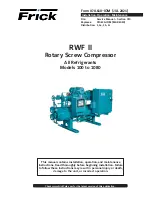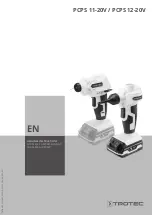
070.610-IOM (JUL 21)
Page 9
RWF II Rotary Screw Compressor Units
Installation
Figure 8: Valve installation
INCORRECT!
CORRECT!
Thermosyphon oil cooling
Thermosyphon oil cooling is an economical, effective
method for cooling oil on screw compressor units. Ther-
mosyphon cooling uses liquid refrigerant at condenser
pressure and temperature that is partially vaporized at the
condenser temperature in a plate and shell vessel, cool-
ing the oil to within 35°F of that temperature. The
vapor,
at
condensing pressure, is vented to the
condenser inlet
and reliquified. This method is the most cost effective of
all currently applied cooling systems since no compres sor
capacity is lost or compressor power penalties in curred.
The vapor from the cooler need only be con densed, not
compressed. Refrigerant flow to the cooler is automatic,
driven by the thermosyphon principle and cooling flow
increases as the oil inlet temperature rises.
Equipment
- The basic equipment required for a ther-
mosyphon system consists of:
1.
A source of liquid refrigerant at condensing pressure
and temperature, located in close proximity to the unit
to mini mize piping pressure drop. The liquid level in the
refrigerant source must be 6 ft to 8 ft minimum above the
center of the oil cooler.
2.
A plate and shell oil cooler with:
Plate Side:
Oil 400 psi design
Shell Side:
Refrigerant 400 psi design
Due to the many variations in refrigeration system design
and physical layout, several systems for assuring the above
criteria are possible.
WARNING
Do not energize the heaters when there is no oil in the
unit, the heat ers will burn out. The oil heat ers will be
energized whenever 120 V control power is applied to
the unit and the com pressor is not run ning, unless the
16 amp circuit breaker in the micro enclosure is turned
off.
Oil filters
NOTICE
Use of
filter elements other than Frick may cause
warranty claim to be denied.
The oil filter(s) and coalescer element(s) shipped with the
unit are best suited to ensure proper filtration and operation
of the system.
Suction valve mounting
The suction isolation valve is shipped loose from the fac-
tory, so it can be installed at various positions within the
suction line piping to the compressor.
Do not install
the
valve at the compressor suction with flow
against the
cone/button.
. When the isolation valve is
installed in this position, uneven flow is generated across
the suction check valve which is mounted at the inlet to
the compressor. This uneven flow causes the disks in the
check valve to strike against the stop pin, and eventually
damage the internals of the check valve. If the isolation
valve is mounted at the compressor suction,
do install
with flow
across the cone/button
.
A length of pipe (up to 12 in. long) must be installed
between the weld neck flange and the stop valve. This
is necessary in order to provide sufficient room for bolt
installation and removal during service. Please design your
system piping accordingly.
CAUTION
After removing the suction sealing disc, confirm that
the check valve hinge pin is in the vertical position! If
the hinge pin is not in a vertical position, then failure
of the check valve may occur.










































